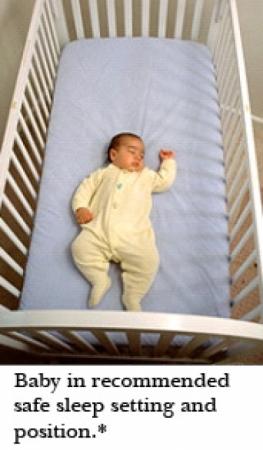SIDS - Reduce Risk
How can I reduce the risk of SIDS?
These steps are recommended to lower a baby’s risk of dying a SIDS death:
1. Provide Safe Sleep (Spanish) for your baby.
- Always place a baby on his/her back to sleep, for naps and at night. Sleeping on his/her side or stomach puts the baby at risk. Ask caregivers to do the same. Find more information here.
- Place a baby on a firm sleep surface, such as on a safety-approved crib mattress, covered by a fitted sheet. Never place a baby on a pillow, quilt, or other soft surface. Find more information on crib safety here.
- Keep soft objects, toys, and loose bedding out of a baby's sleep area.
- Keep the baby's sleep area close to, but separate from, where you and others sleep. Room-sharing is encouraged, but not bed-sharing. Your baby should never sleep in a bed, on a couch, or in an armchair with adults or other children.
- Do not let a baby overheat during sleep. Do not over bundle baby. Baby should be lightly clothed for sleep. Keep room temperature comfortable for a lightly clothed adult.
2. Give your baby a healthy start:
- Do not smoke during pregnancy and do not allow smoking around a baby. Find information on quitting here.
- Avoid alcohol and illicit drug use during pregnancy and after birth.
- If possible, breastfeed your baby. It is best to only breastfeed and not offer formula or other non-human milk-based supplements for six months. See here for breastfeeding information and support.
- Receive regular prenatal care while you are pregnant.
- Infants should be immunized and seen for regular well-child checks.
- Give supervised, awake tummy time: Reduce the chance that flat spots will develop on a baby's head and help development by placing a baby on his/her tummy when he/she is awake and someone is watching. Avoid too much time in car seats, carriers, and bouncers.
3. Other recommendations:
- Think about using a clean, dry pacifier when placing an infant down to sleep. Do not force the baby to take it. Pacifiers should not be coated in any sweet solution. If you are breastfeeding, wait to give the pacifier until after the baby is one month old or until breastfeeding has been established.
- Avoid products that claim to reduce the risk of SIDS. These products include wedges to keep baby in place while sleeping. Also avoid items that claim to lower risk of baby rebreathing stale air. These products have not been found to be effective and they may be dangerous.
- Do not use medical home monitors to reduce the risk of SIDS. Medical home monitors may be recommended by your doctor for other reasons.
* Picture courtesy of Eunice Kennedy Shriver National Institute of Child Health and Human Development (NICHD), NIH, DHHS.

